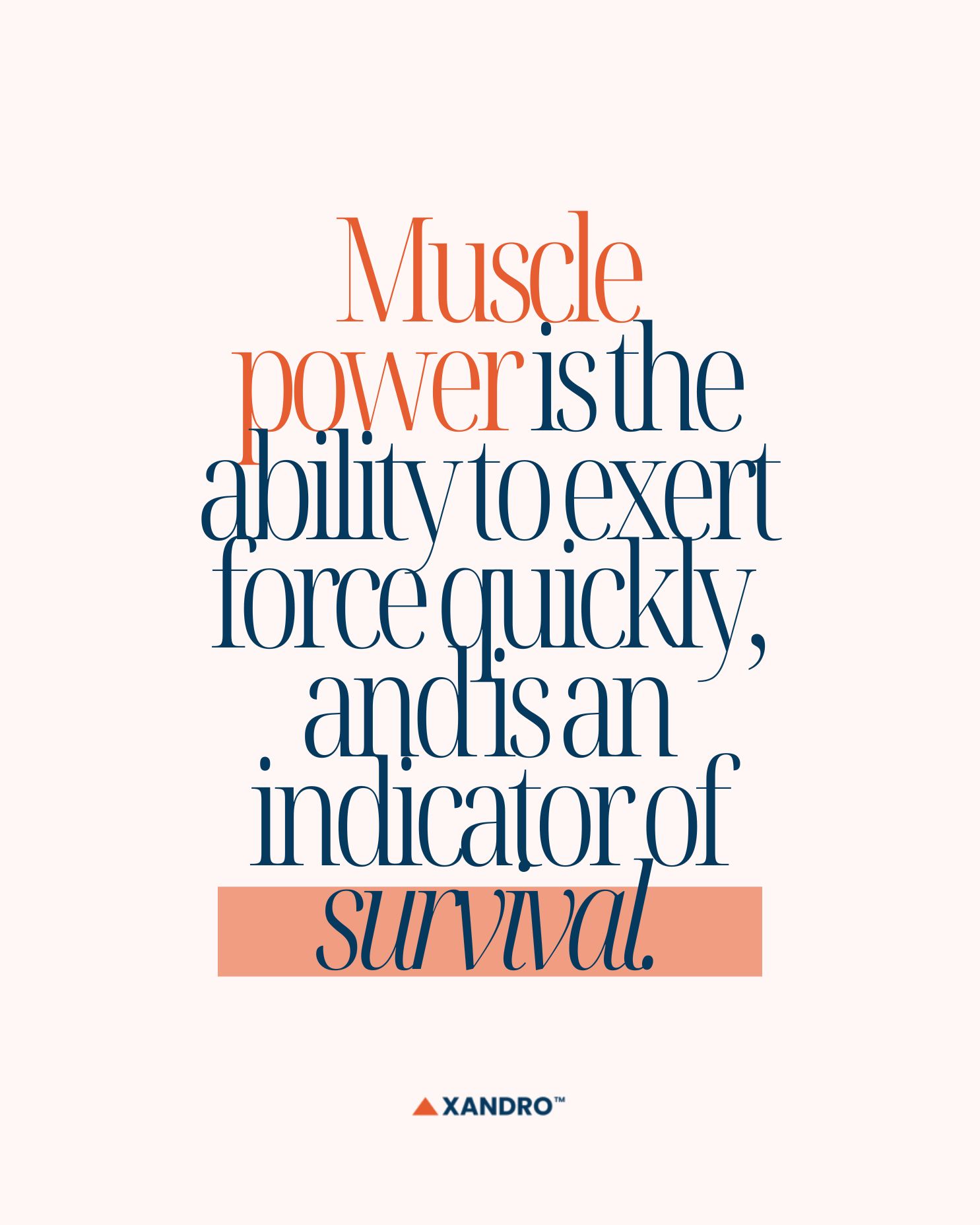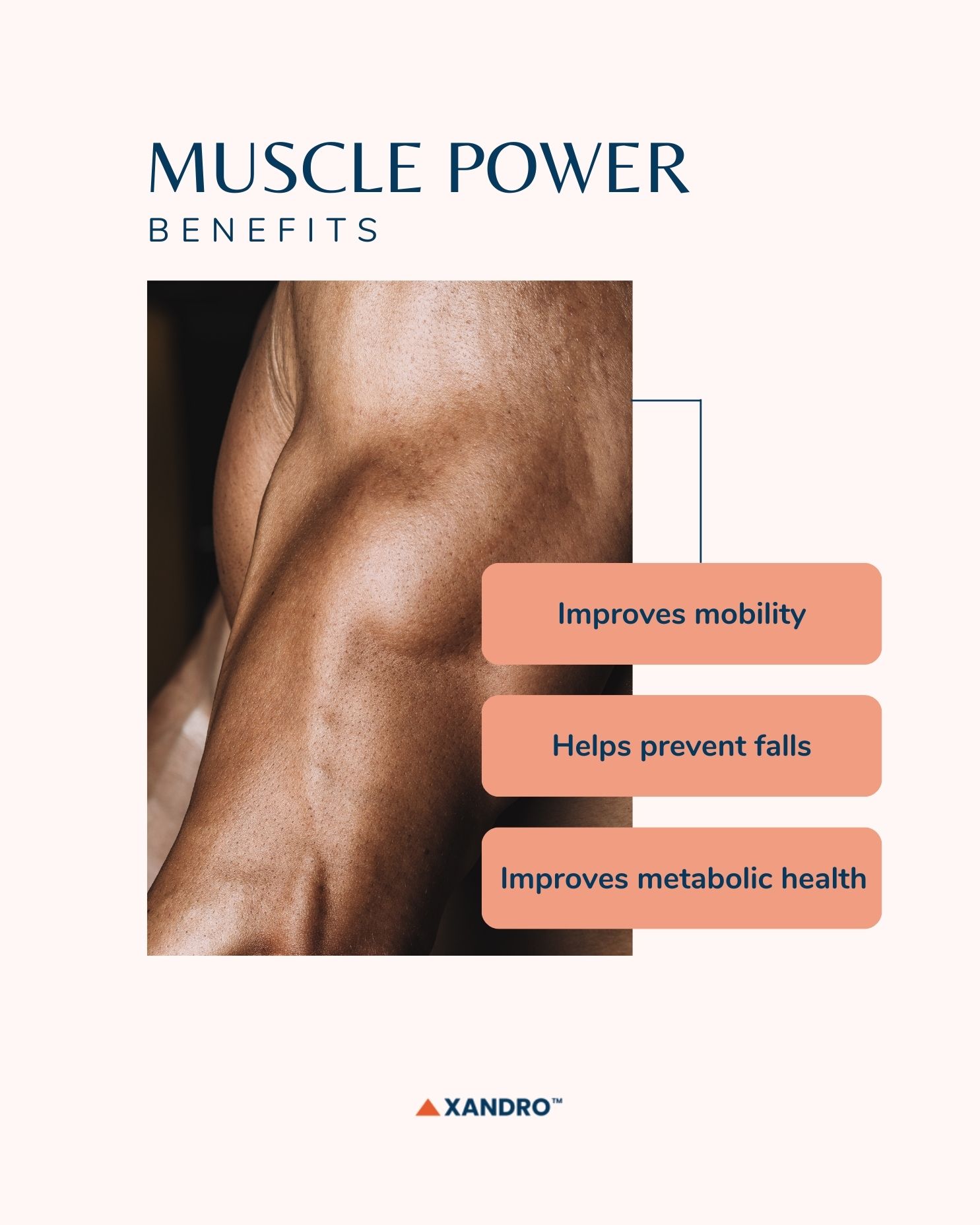Unlock the Secret to Longevity: Muscle Mass, Strength and Power
18th Jan 2025
Muscle Power: The Key to Longevity and Vitality
When you think about living a long, healthy life, what comes to mind? Eating well? Staying lean? While these are undoubtedly important, there’s a lesser-known but incredibly impactful factor you should focus on: muscle power.
Is muscle power the same as strength? No, muscle power isn’t just about being strong; it’s about how quickly and efficiently your muscles can generate force, and research shows that muscle power might be one of the strongest predictors of longevity, even more than that importance of muscle mass.
Products mentioned in this post:
Here's why building muscle strength and power could be one of the best investments in your future health.
What is Muscle Power and Why Muscle Power Matters?
Muscle power — the ability to exert force quickly — is incredibly important for everyday tasks like climbing stairs, standing up or catching yourself if you stumble. It’s also a powerful predictor of survival.
A longevity research study has shown that older adults with normal or high muscle power have a significantly better chance of living longer than those with low muscle power — by nine years! In fact, the survival benefits of being powerful extend even to individuals with higher body fat.
Here are some fascinating findings:
- Fat but Powerful Paradox: Older adults who are ‘fat but powerful’ enjoy similar mortality benefits to those who are lean and powerful, reducing their risk of death by 43-45 per cent.
- Lean and Weak vs. Fat and Weak: Being lean offers no survival advantage if muscle power is low. Muscle power trumps body composition when it comes to longevity.
- Adiposity Impact: Excess body fat does influence health, but the detrimental effects can be partially offset by maintaining high muscle power.
Further Reading: The Benefits of Magnesium on Muscles

The Ageing-Muscle Connection
As we age, our bodies gradually decline in muscle mass, strength and power. Starting around age 50:
- Muscle mass decreases by about 1 to 2 per cent per year.
- Muscle strength declines by 1.5 per cent per year and then 3 per cent per year after 60.
- Muscle power decreases even faster than strength or mass, making it a sensitive marker of ageing.
Dynamic power, which involves generating force quickly, is another crucial component. Activities that require both strength and speed, such as arm cranking or powerlifting movements, are better predictors of longevity than static exercises like holding a weight in place. This is because dynamic power uses both your muscles and your nervous system, improving coordination and functionality.
This accelerated decline has led researchers to coin a new term: powerpenia, the age-related loss of muscle power. Powerpenia differs from sarcopenia (age-related loss of muscle mass) and highlights the unique and important role of power in maintaining functional independence and preventing falls.
Further Reading: The Benefits of Calcium AKG on Muscle Recovery
Muscle Power and Longevity: The Science
Muscle power’s predictive value for longevity isn’t just about surviving longer; it’s about thriving. Power training improves:
- Mobility: Allows for better movement and independence.
- Fall Prevention: Reduces the risk of injury, a significant cause of disability in older adults.
- Metabolic Health: Improves insulin sensitivity and overall metabolic function.
Longevity studies in humans have shown that low muscle strength and power are independently associated with higher mortality rates. Interestingly, in younger adults (<60 years), the rate of strength decline matters most, while in older adults (≥60 years), absolute strength is more protective.
One study involving nearly 4,000 participants aged 41 to 85 years examined the impact of muscle power on survival. Researchers measured participants' maximal muscle power through an upright row exercise and followed them for an average of 6.5 years. The results were striking:
- Participants in the lowest quartile of muscle power had a 10 to 13 times higher risk of dying compared to those in the highest quartiles.
- Even being in the second quartile posed a 4 to 5 times greater risk of death compared to the highest quartile.
These findings highlight the importance of building and maintaining muscle power, especially as we age.
Further Reading: Muscles and Menopause

How to Preserve and Build Muscle Power
It’s never too late to take action with your health and longevity. With the right training and nutrition, you can maintain — or even improve — your muscle power. Here’s how:
1. Do Power Training
Power training focuses on fast, explosive movements and delivers unique benefits for functional outcomes. Building muscle power doesn't require you to become a professional athlete. Instead, focus on exercises that combine strength and speed.
Here are some examples and tips:
- Fast Step-Ups: Step onto a sturdy platform as quickly as possible, with or without added weight.
- Chair Stands: Stand up from a chair repeatedly for 30–60 seconds, aiming for speed.
- Stair Climbing: Climb stairs quickly, optionally wearing a weighted vest.
- Weighted Push-Ups or Pull-Ups: Perform these with a focus on speed during the lifting phase.
You can also adapt traditional exercises like squats and deadlifts by focusing on speed during the lifting phase while maintaining proper form.
2. Increase Protein Intake
Enough protein is essential for muscle maintenance and growth. Aim for 1.2 to 1.6g of protein per kilogram of body weight daily. For building muscle, aim to get up to 2g of protein per kilogram of body weight each day. Spread your protein intake throughout the day for the best absorption.
3. Strength Train Regularly
Commit to resistance training 2–3 times per week. Building foundational strength complements power training and helps reduce muscle loss as you age.
Tips for muscles and longevity:
- Choose the Right Weight: Use a weight that's challenging but not impossible to lift. Aim for 1 to 3 sets of 6 to 8 repetitions.
- Focus on Speed: Perform the lifting phase as quickly as possible while maintaining proper form. Lower the weight slowly to its starting position.
- Incorporate Variety: Include exercises for both the upper and lower body and switch them up regularly to keep your routine engaging and effective.
- Listen to Your Body: Avoid pushing through significant pain or discomfort. Adjust weights and repetitions as needed to prevent injury.
- Speak With a Professional: Speak with a doctor or fitness trainer before starting a new exercise program, especially if you have pre-existing health conditions.
Some effective power-building exercises include squats, deadlifts, bench presses and upright rows performed with an emphasis on speed during the lifting phase. Activities like stair climbing, push-ups and fast-paced step-ups can also help improve power.
Further Reading: How Muscles Impact Metabolism
End Note
Muscle strength and power are more than just markers of fitness — they're indicators of how well you'll age. By incorporating resistance training and focusing on dynamic power, you can significantly improve your chances of living a longer, healthier life. Start small, stay consistent and watch as your efforts translate into improved strength, independence and vitality for years to come.
If you’re experiencing muscle cramps as you’re building muscle power, Magnesium Glycinate can help reduce these, while Calcium AKG can help improve muscle strength, endurance and recovery, which is great for helping you achieve your fitness goals. To learn more about muscle longevity read through our blogs!
Products mentioned in this post:
